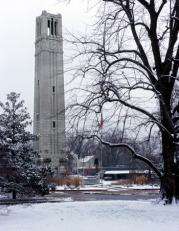New methodology improves winter climate forecasting

It's hot out right now, but new research from North Carolina State University will help us know what to expect when the weather turns cold. Researchers have developed a new methodology that improves the accuracy of winter precipitation and temperature forecasts. The tool should be valuable for government and utility officials, since it provides key information for use in predicting energy consumption and water availability.
"Predicting winter precipitation is extremely useful, because winter is the most important season in terms of re-charging water supplies in the United States, ensuring water will be available in the summer," says Dr. Sankar Arumugam, author of the study and an assistant professor of civil, construction and environmental engineering at NC State. The study was co-authored by Naresh Devineni, a Ph.D. student at NC State.
"Predicting temperature is also important, because temperature determines energy consumption," Arumugam says. "When it is very cold, people use more energy to heat their homes."
The researchers were able to reduce uncertainty in winter climate predictions over the United States by developing a methodology that incorporates multiple general climate forecast models (GCMs) and also accounts for the activity - or inactivity - of El Nino conditions in the Pacific.
Winter precipitation and temperature over many regions of the continental United States are predominantly determined by the El Nino Southern Oscillation (ENSO), which denote hot (El Nino) or cold (La Nina) sea surface temperature conditions in the tropical Pacific.
Most GCMs are better at predicting the winter climate when ENSO is quite active, and are less accurate under neutral ENSO conditions. The methodology developed by the researchers accounts for the skill of the models under active and neutral ENSO conditions in combining multiple GCMs, resulting in reduced uncertainty in predicting the winter climate.
"Improving precipitation and temperature predictions should help government, water and energy utility officials plan more effectively," Arumugam says, "because they will have a better idea of what conditions to expect."
More information: The study, "Improving the Prediction of Winter Precipitation and Temperature over the continental United States: Role of ENSO State in Developing Multimodel Combinations," was published online this month by Monthly Weather Review.
Provided by North Carolina State University















